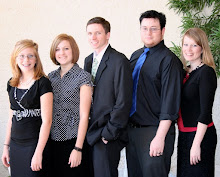 Wallace Ove Tanner was born in the upstairs bedroom of his maternal grandparent's red brick home. He was given his Danish great grandfather's name; Ove. He arrived as one of John Tanner's posterity, fifth generation removed. Likewise the English lines of Parkinson, Godfrey, DeFriez and Jarvis are notable as are the Danish names Christensen and Ove(r)son. Pioneer stock all; Mormon colonists first to Utah and San Bernardino, California, and then to the little nondescript northeastern Arizona town of St. Johns, Arizona. Where the grandfather built the red brick home with his own hands. Where that house still stands. We buried him there next to his wife two Saturdays ago. They passed away 11 days apart.
Wallace Ove Tanner was born in the upstairs bedroom of his maternal grandparent's red brick home. He was given his Danish great grandfather's name; Ove. He arrived as one of John Tanner's posterity, fifth generation removed. Likewise the English lines of Parkinson, Godfrey, DeFriez and Jarvis are notable as are the Danish names Christensen and Ove(r)son. Pioneer stock all; Mormon colonists first to Utah and San Bernardino, California, and then to the little nondescript northeastern Arizona town of St. Johns, Arizona. Where the grandfather built the red brick home with his own hands. Where that house still stands. We buried him there next to his wife two Saturdays ago. They passed away 11 days apart.Somewhere in between the beginning and the end of his long life story, my world intersected with his. I married one of his sons. My children are his grandchildren. Our son James is the very image of his grandfather. Comparative photos of the two almost take your breath away.
New to this family with the famous last name, I was enthralled with all things TANNER. Lucky for me, my father-in-law was always in the mood to talk about his very interesting life. I used to feel sorry I had no roots to his home town, our summer family reunion destination. This was a place that shouted belonging to history, to coming from significant struggle and surviving the loneliness and uncertainty of the colonist's life.
 Original pioneer structures defy time and logic in their God-given tenacity.The old church on the highway hosted a 2 hour Sacrament meeting sweltering in the over-crowded chapel and adjoining hall every 24th of July. I wished I could join the tearful testimonies about beloved, brave ancestors who obeyed Brigham Young and left beautifully abundant places like Bountiful, Utah, to come to this high-desert cedar tableland deep in Indian territory. Besieged by disheartening drought and imperiled by an earthen dam that failed tragically time after time ~ still, the faithful stayed.
Original pioneer structures defy time and logic in their God-given tenacity.The old church on the highway hosted a 2 hour Sacrament meeting sweltering in the over-crowded chapel and adjoining hall every 24th of July. I wished I could join the tearful testimonies about beloved, brave ancestors who obeyed Brigham Young and left beautifully abundant places like Bountiful, Utah, to come to this high-desert cedar tableland deep in Indian territory. Besieged by disheartening drought and imperiled by an earthen dam that failed tragically time after time ~ still, the faithful stayed.
Their children grew up roping cattle and moved to Phoenix. Many of them married city girls and began their careers. Far more than one would expect for a town that maintained a population of around 1200 for almost a hundred years (until the Bechtel plant was built), the native sons and daughters married each other and came back home to sacred ground. Some survived the trenches of WWI, only to meet eternity broadsided by the evening flyer train. Sturdy, instantly recognizable Arizona colony names like Platt, Hamblin, Peterson, Hatch, Tenney, Farr and Udall, all have sons and daughters who remained or have returned home.
About 10 years ago I was surprised to discover my family roots in St. Johns are ~ after all this time ~ legitimate and documented! My English immigrant great-great grandfather Benjamin Peel and his wife Nancy Turnbull lived in St. Johns for 2 years before continuing South to the Graham County colonies of Pima/Layton/Safford. It shouldn't make that much difference, but it does.
The locals are fiercely and unabashedly loyal to their home town. This busting-pride is never more apparent than at seasonal High Holy Days like the 4th of July, and of course, Pioneer Day on the 24th of July. Both open with a bang literally as a cannon is fired off thunderously at dawn from the corner of the court house - (which happens to be a stone's throw from the Tanner homestead on the hill). I loved it. Soon to follow was the pancake breakfast at the park, and then a mid-morning parade down the middle of the highway. You could count on my father-in-law taking a million blurry pictures of every single ridiculously Mormon-themed float that rolled by; glorious concoctions emblazoned with scripture quotes, slightly disfigured paper-mache Angel Moronis and trailing tattered crepe paper. Fist-fulls of hard candy and water balloons were flung out to an appreciative crowd. Each year we would watch Grandpa's reunion shirt intersect doggedly with the spectators. He was truly in his element seeking out familiar old faces and shaking hands, hoping their renewed conversation would be under a tree. Alarming us, he would abruptly cross the road perilously close to the red, white and blue festooned parade firetruck or desperadoes atop skittish, side-stepping horses. His hand extended, we saw he was just greeting another kindred spirit. Snow cones never tasted sweeter than on the sweaty sidelines of this wonderful, entirely predictable spectacle.
It was very quiet when we crested the hill and stepped out onto the tumbleweed-spawned soil of the St. Johns cemetery.
 The ever-present wind pulled our hair and the moisture from our lips. This place is familiar to my children. It is not creepy or morbid; it is where the ancestors are waiting beneath blushing, simple old sandstone grave markers. But they lie to the north, in the Pioneer section. Today we are gathering around a fresh grave we left only 2 weeks previous. These are just two of about 27 plots grandpa purchased years ago, hoping to line us all up together. He said it was "the best view" of "old town". There is nothing left of old town, the original settlement. Just alternating fields of sweet alfalfa, ochre colored dirt and pasture land. Grazing livestock decorate the most pastoral of scenes.
The ever-present wind pulled our hair and the moisture from our lips. This place is familiar to my children. It is not creepy or morbid; it is where the ancestors are waiting beneath blushing, simple old sandstone grave markers. But they lie to the north, in the Pioneer section. Today we are gathering around a fresh grave we left only 2 weeks previous. These are just two of about 27 plots grandpa purchased years ago, hoping to line us all up together. He said it was "the best view" of "old town". There is nothing left of old town, the original settlement. Just alternating fields of sweet alfalfa, ochre colored dirt and pasture land. Grazing livestock decorate the most pastoral of scenes.He was right. It is a lovely view.
 When the wind turns, we can hear the muffled booming of the announcer intermittently from the fair grounds. Heads are bowed as we strain to hear the second son pronounce the dedication of his father's grave. I am standing next to him. He is my husband. He feels what we all know: the Native Son has returned home at last.
When the wind turns, we can hear the muffled booming of the announcer intermittently from the fair grounds. Heads are bowed as we strain to hear the second son pronounce the dedication of his father's grave. I am standing next to him. He is my husband. He feels what we all know: the Native Son has returned home at last.









4 comments:
So sorry for your loss - 2 at once has to be difficult. It's so great that you learned so much about his life and roots.
That was a lovely read.
You made me feel a part of the family. Death is hard and it seems harder when the second parent passes on. There is an emptiness left by the second not quite expressed by the first. The second, it seemed for me anyway, requires a very different level and deepness of feeling and introspection. The ultimate reunion seems that much closer...
We, too, have a small family plot. In 1901 my great grandmother lost her second son at 18 years of age. He was just beginning a promising career as a civil engineer for the city of Washington DC. He stopped one day to drink from a puddle, and died shortly thereafter of typhoid. She bought a plot of ten graves. There are two left to be filled...
The plot is beside a typical, stained-glass and brick Episcopal church on a small hill on Route 1 in Beltsville MD. The view must have been beautiful, at one time. The church is now lost among gas stations, fast fooderies, a shopping plaza, the University of Maryland (Agricultural School), neighborhoods and just sprawling clutter.
I look at the view from your family plot and it is a joy.
nice job!
Post a Comment